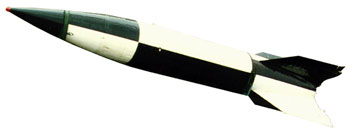German Army V2 (Assembly 4)
| Serial No: | n/a |
| Period: | WWII |
| Reference: | 85/O/164 |
| Museum: | Midlands |
| Location: | War in the Air |
| On Display: | Yes |
Under the terms of the Treaty of Versailles in 1919 Germany was forbidden to manufacture heavy artillery. This ban forced the German Army to consider the use of rockets for long range bombardment.
This interest in rocket propulsion went back to 1929 when it was under the control of Army Captain Walter Dornberger who was joined three years later by the 19 year old Wernher Von Braun. They were developing the A series missiles, later to lead to the development of the A4 (V2) missile in parallel with the development of the V1.
However, the difficulties experienced during the development programme meant that a suitable rocket motor was not produced until 1940, and the first successful launch did not take place until 3 October 1942.
The first V2 fell on British soil at Chiswick at 6.43pm on 8 September 1944. Although some 10,000 A4s were produced, only about 3,000 were launched offensively.
The V2 was conceived as an extension to artillery, and was thus planned as a mobile weapon for field use. Primarily moved by rail – it was just able to pass through a railway tunnel – it was mounted on a Meillerwagen, a wheeled Transporter/Launcher, with a hydraulic ram to elevate it to 90 degrees.
The system was operational, after arrival at an unsurveyed site, within 4 hours. Soon after launch the V2 turned and reduced its climb angle to 40 degrees to the vertical. The motor was cut by the guidance system when the correct velocity was achieved for the ballistic trajectory to take it to the target.






